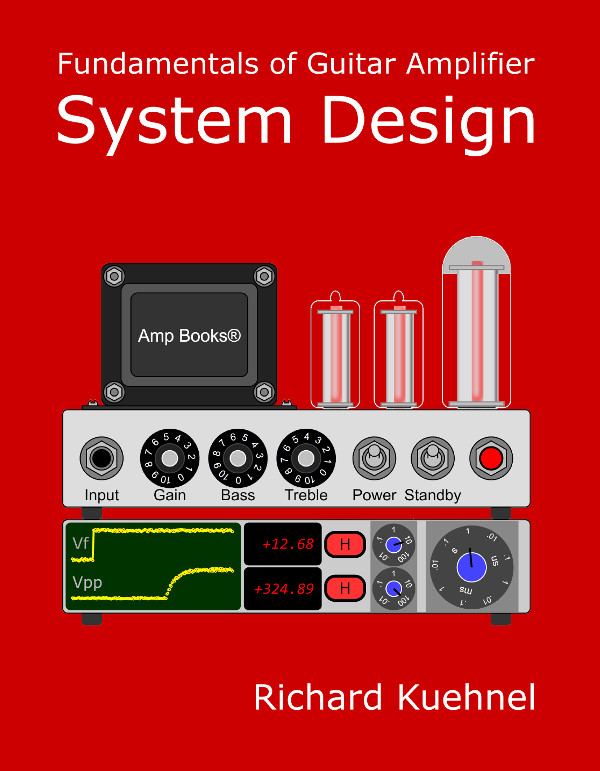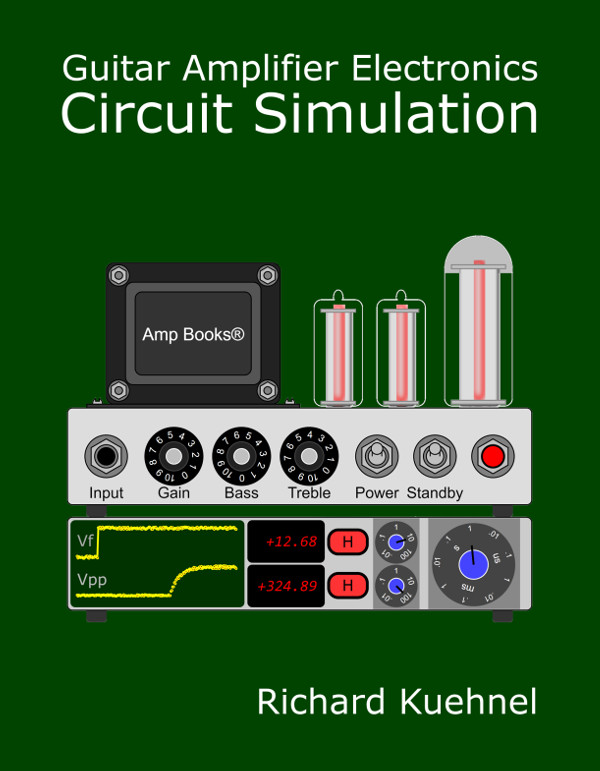Circuit Analysis of the Garnet Banshee
The Garnet Banshee guitar amplifier is powered by a 12AX7 dual triode and a 6V6 power tube. Unlike a vintage Fender Champ, which has the same tube lineup, it has bass and treble controls courtesy of a James tone stack. Let's investigate the implications of adding this feature.
Power Amp
Like the Champ's, the Banshee's power amp is cathode biased.

The plate and screen voltages are almost equal, so we can use the triode-connected plate characteristics to determine the DC operating point. Since the screen has more control over plate current than the plate, we use the screen voltage for the triode's "plate" voltage. If the grid bias is -15V, the triode's plate-to-cathode voltage is 300V. If the grid bias is -20V, the plate-to-cathode voltage is 295V. These endpoints define the red line shown here.

According to Ohm's Law, if voltage across the 470Ω cathode resistor is 15V, 20V, or 25V, the "plate" current is
15V / 470Ω = 32mA
20V / 470Ω = 42.5mA
25V / 470Ω = 53mA
These three points define the blue line segments which intersect the red line at a DC grid voltage of -19V and a DC "plate" current of 40mA. This is identical to the Fender Champ 5E1, which has a DC plate current of 37mA and a DC screen current of 3mA.

|
Guitar Amplifier Electronics: Fender Deluxe - from TV front to narrow panel to brownface to blackface Reverb |
The screen-to-cathode voltage is 296V. The DC plate-to-cathode voltage is
320V - 19V = 301V
The published plate characteristics for the 6V6 do not contain a 0V grid curve for a 296V screen. The transfer characteristics, however, contain an important reference point: a plate current of 140mA for a 296V screen, 0V grid, and 250V plate, as marked by the blue dot in the upper right corner.

This point can serve as an anchor point for the estimated 296V curve shown here in blue.

The red dot marks the DC operating point (301V, 37mA) on the plate characteristics. The output transformer primary impedance is 5.5kΩ. According to Ohm's Law, if the plate voltage decreases by 301V then the plate current increases by
301V / 5.5kΩ = 55mA
This marks the upper left endpoint of the red load line. Maximum plate voltage swing is 480V peak-to-peak. Maximum plate current swing is 88mA peak-to-peak, so maximum power is in the neighborhood of
(480V)(88mA) / 8 = 5.3W
The DC grid bias is -19V, so input sensitivity, the input signal level needed to drive the amp to full power, is 19V peak (+22.6dBV).

|
Guitar Amplifier Electronics: Basic Theory - master the basics of preamp, power amp, and power supply design. |
Power Amp Driver
The 12AX7 driver's cathode serves as the injection point for negative feedback from the 4Ω tap of the output transformer secondary.

Under DC conditions, the capacitors are open circuits. The 47Ω resistor is much smaller than the 2.7kΩ resistor so the two in parallel are approximately 47Ω. This puts 1.547kΩ between the cathode and ground. The 12AX7 calculator indicates that the triode is biased at a neutral -1.5V.


The 50μF capacitor is more than enough to fully bypass the 1.5kΩ resistor for audio frequencies, so for the purposes of determining the voltage gain when loaded by the 220kΩ grid-leak resistor, we can consider the triode to have a tiny 47Ω unbypassed cathode resistor. According to the Cathode Bypass Capacitor calculator, the loaded voltage gain is 34.1dB.

The Banshee introduces only a slight amount of negative feedback from the output transformer secondary, which reduces gain by only 2.3dB compared to the same circuit without feedback. For the Champ 5E1 it is 3.4dB,1 which is still quite modest. The Garnet's voltage gain with feedback is therefore 31.8dB. Input sensitivity at the triode grid is
22.6dBV - 31.8dB = -9.2dBV (490mV peak)
This is more than a single-coil pickup can produce, so at least one more voltage amplification stage is required.

|
Fundamentals of Guitar Amplifier System Design - design your amp using a structured, professional methodology. |
According to the Preamp Gain and Output Impedance calculator, the output impedance of the power amp driver is 40kΩ.

The Coupling Capacitor calculator indicates that with a 0.01μF value, gain at 82Hz, which is the lowest note on a guitar with standard tuning, is down by only 2.1dB. Negative feedback from the output transformer secondary flattens the frequency response,2 so the actual bass attenuation is even less.

Tone Stack and Volume Control
The Banshee uses a James tone stack driven by a 12AX7 voltage amplifier with a 38kΩ output impedance.

Here is the frequency response based on SPICE simulation.3

The volume control is set to 50-percent rotation, 10-percent resistance. The tone controls are set to minimum, 50-percent rotation, and maximum for a total of 9 traces. The controls have a 15-percent audio taper, which provides a flatter response with the controls at 50-percent rotation compared to a standard 10-percent audio taper.4 The SPICE simulation takes into account the 38kΩ output impedance, so for the purposes of determining input sensitivity at the input to the first-stage voltage amplifier, we need its unloaded gain. Insertion loss with all controls at noon is about 38dB. With the volume cranked to maximum it becomes 18dB. Crank all controls to maximum and we still get 11dB insertion loss.

|
Guitar Amplifier Electronics: Circuit Simulation - know your design works by measuring performance at every point in the amplifier. |
First Stage Voltage Amplifier
The first stage, with its 100kΩ plate load resistor and fully bypassed cathode resistor has become so ubiquitous in guitar amp design that it has even been called a standard 12AX7 voltage amplifier.5

Even the gamma network at the front end is classic Fender: two 68kΩ resistors in parallel for an equivalent of 34kΩ. Unloaded gain for the first stage is 35.8dB.

Input sensitivity at the guitar input jack with all controls at 50-percent rotation is therefore
-9.2dBV + 38dB - 35.8dB = -7dBV (632mV peak)
With the volume control at maximum, sensitivity gets a 20dB boost to become -27dBV (63mV peak). This is within the capabilities of a single-coil pickup, but barely. With all controls at maximum, sensitivity is -34dBV (28mV peak). For comparison, the Champ 5E1, which lacks tone controls, has an input sensitivity of -17.4dBV (191mV peak) with the volume control a noon.6 With the volume at maximum sensitivity becomes -37.4dBV (19mV peak).
The Champ has no tone controls but lots of gain.
"It is uncluttered, but at anything more than mid-morning on the volume dial, it will start to break up pretty fast. Crank it up and it can sound great or pure flub incarnate, depending on your tastes." 7 -Dave Hunter
Garnet converts a big chunk of that gain into insertion loss for a full stack. Whether the loss in gain is worth the added feature may depend on whether you use humbuckers and/or boost pedals. Or perhaps your taste for "flub incarnate."
References
1Richard Kuehnel, Guitar Amplifier Electronics: Basic Theory, (Seattle: Amp Books, 2018), pp. 145-150.
2Richard Kuehnel, Fundamentals of Guitar Amplifier System Design, (Seattle: Amp Books, 2019), pp. 131-133.
3Richard Kuehnel, Guitar Amplifier Electronics: Circuit Simulation, (Seattle: Amp Books, 2019), pp. 33-37.
4Richard Kuehnel, Guitar Amplifier Electronics: Basic Theory, (Seattle: Amp Books, 2018), pp. 13-15, 95-100.
5Richard Kuehnel, Fundamentals of Guitar Amplifier System Design, (Seattle: Amp Books, 2019), pp. 21-22.
6Richard Kuehnel, Guitar Amplifier Electronics: Circuit Simulation, (Seattle: Amp Books, 2019), pp. 65-67.
7Dave Hunter, Amped, (Minneapolis: Voyageur Press, 2012), p. 40.

|
From system design concepts to individual stage operation, an all-new examination of Bassman electronics. |


